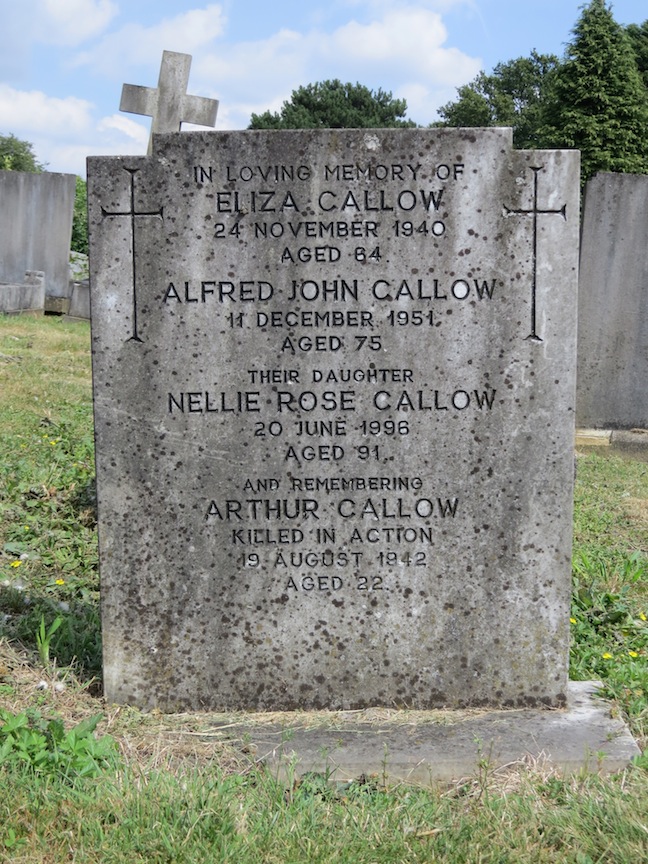Service Number: PLY/X3413
Regiment: Royal Marines
Unit: No. 40 R.M. Commando.
Died: 19th August 1942
Age: 22 years old
Arthur was the son of Alfred John and Eliza Callow (née Cornwell), of Palmers Green, Middlesex. They had married on the 25th November 1900 at St Michael at Bowes Church, Southgate, London.
Arthur was one of ten children. He was born on the 28th April 1920 in Southgate and baptised on the 6th June 1920 in the same church his parents had married in.
During WW2 Arthur had joined the Royal Marines, been trained as a Commando, and joined No 40 R.M Commando Unit.
On the 19th August 1942 Operation Jubilee or the Dieppe Raid began. This was an Allied amphibious attack on the German-occupied port of Dieppe inn northern France. Over 6,050infntry predominantly Canadian, supported by a regiment of tanks, were put ashore from a naval force operating under protection RAF fighters.
The port was to be captured and held for a short period, to test the feasibility of a landing and to gather intelligence. German coastal defences, port structures and important buildings were to be demolished. The raid was intended to boost Allied morale, demonstrate the commitment of the UK, to re-open the Western Front and support the Soviet Union, fighting on the Eastern Front.
Aerial and naval support was insufficient to enable the ground forces to achieve their objectives; the tanks were trapped on the beach and the infantry was largely prevented from entering the town by obstacles and German fire. After less than six hours, mounting casualties forced a retreat. The operation was a fiasco in which only one landing force achieved its objective and some intelligence including electronic intelligence was gathered.
Within ten hours, 3,623 of the 6,086 men who landed had been killed, wounded or became Prisoners of war. The Luftwaffe made a maximum effort against the landing as the RAF had expected, but the RAF lost 106 aircraft (at least 32 to anti-aircraft fire or accidents) against 48 German losses. The Royal Navy lost 33landing craft and a destroyer.
Both sides learned important lessons regarding coastal assaults. The Allies learned lessons that influenced the success of the D-Day landings. Artificial harbours were declared crucial, tanks were adapted specifically for beaches, a new integrated tactical air force strengthened ground support, and capturing a major port at the outset was no longer seen as a priority. Churchill and Mountbatten both claimed that these lessons had outweighed the cost. The Germans also believed that Dieppe was a learning experience and made a considerable effort to improve the way they defended the occupied coastlines of Europe.
Arthur was sadly killed on this raid and was buried in Escalles Churchyard. He is commemorated on the family headstone in Southgate Cemetery, in North London along with his parents and older sister Nellie.
(Sources: CWGC, Ancestry, Find My Past, National Archives, Commando Veterans Archive, Wikipedia)
(Bio: Woose)
Service Number: PLY/X3413
Regiment: Royal Marines
Unit: No. 40 R.M. Commando.
Died: 19th August 1942
Age: 22 years old
Arthur was the son of Alfred John and Eliza Callow (née Cornwell), of Palmers Green, Middlesex. They had married on the 25th November 1900 at St Michael at Bowes Church, Southgate, London.
Arthur was one of ten children. He was born on the 28th April 1920 in Southgate and baptised on the 6th June 1920 in the same church his parents had married in.
During WW2 Arthur had joined the Royal Marines, been trained as a Commando, and joined No 40 R.M Commando Unit.
On the 19th August 1942 Operation Jubilee or the Dieppe Raid began. This was an Allied amphibious attack on the German-occupied port of Dieppe inn northern France. Over 6,050infntry predominantly Canadian, supported by a regiment of tanks, were put ashore from a naval force operating under protection RAF fighters.
The port was to be captured and held for a short period, to test the feasibility of a landing and to gather intelligence. German coastal defences, port structures and important buildings were to be demolished. The raid was intended to boost Allied morale, demonstrate the commitment of the UK, to re-open the Western Front and support the Soviet Union, fighting on the Eastern Front.
Aerial and naval support was insufficient to enable the ground forces to achieve their objectives; the tanks were trapped on the beach and the infantry was largely prevented from entering the town by obstacles and German fire. After less than six hours, mounting casualties forced a retreat. The operation was a fiasco in which only one landing force achieved its objective and some intelligence including electronic intelligence was gathered.
Within ten hours, 3,623 of the 6,086 men who landed had been killed, wounded or became Prisoners of war. The Luftwaffe made a maximum effort against the landing as the RAF had expected, but the RAF lost 106 aircraft (at least 32 to anti-aircraft fire or accidents) against 48 German losses. The Royal Navy lost 33landing craft and a destroyer.
Both sides learned important lessons regarding coastal assaults. The Allies learned lessons that influenced the success of the D-Day landings. Artificial harbours were declared crucial, tanks were adapted specifically for beaches, a new integrated tactical air force strengthened ground support, and capturing a major port at the outset was no longer seen as a priority. Churchill and Mountbatten both claimed that these lessons had outweighed the cost. The Germans also believed that Dieppe was a learning experience and made a considerable effort to improve the way they defended the occupied coastlines of Europe.
Arthur was sadly killed on this raid and was buried in Escalles Churchyard. He is commemorated on the family headstone in Southgate Cemetery, in North London along with his parents and older sister Nellie.
(Sources: CWGC, Ancestry, Find My Past, National Archives, Commando Veterans Archive, Wikipedia)
(Bio: Woose)
Inscription
GOD TAKES OUR LOVED ONES
FROM OUR HOMES
BUT NEVER FROM OUR HEARTS
Sponsored by Ancestry
Advertisement
Explore more
Sponsored by Ancestry
Advertisement




